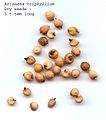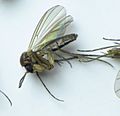Indian turnip facts for kids
Quick facts for kids Indian turnip |
|
|---|---|
| Scientific classification | |
| Genus: |
Arisaema
|
| Species: |
quinatum
|
| Synonyms | |
|
|
Arisaema quinatum, also known as the Indian turnip or jack-in-the-pulpit, is a cool plant found in the southeastern United States. It belongs to the Araceae family, which includes other interesting plants like calla lilies and taro. You can find this plant growing naturally from Texas and Florida all the way north to Kentucky and North Carolina.
Contents
Meet the Jack-in-the-Pulpit Plant
This plant gets its fun common name, "jack-in-the-pulpit," because of its unique flower. The flower looks a bit like a person (the "jack") standing inside a hooded pulpit. The "pulpit" part is actually a leaf-like structure called a spathe. It wraps around the real flowers, which are tiny and grow on a central stalk called a spadix.
Where Does This Plant Grow?
The jack-in-the-pulpit plant likes to grow in damp, shady places. You can often spot it in forests, woodlands, and along stream banks. It is native to a large area of the southeastern United States. This includes states like Texas, Florida, Georgia, Alabama, Mississippi, Louisiana, South Carolina, North Carolina, Tennessee, and Kentucky.
How to Identify This Plant
For a long time, Arisaema quinatum was thought to be just a type of another common plant, A. triphyllum. However, scientists now agree that Arisaema quinatum is its own special species.
The easiest way to tell Arisaema quinatum apart is by looking at its leaves. Most jack-in-the-pulpit plants have leaves made of three smaller parts, called leaflets. But Arisaema quinatum is special because its leaves usually have five leaflets. This five-leaflet pattern helps you know you've found this particular plant.
Life Cycle of the Jack-in-the-Pulpit
Jack-in-the-pulpit plants grow from a corm, which is like a small, round underground stem. In spring, the plant sends up its unique flower and leaves. After the flower is pollinated, it develops into a cluster of bright red berries in late summer and fall. These berries contain the seeds.
The Berries and Seeds
The bright red berries are very noticeable in the fall. They are packed together on the spadix, which now stands upright. Each berry holds several seeds. These seeds are how the plant reproduces and spreads to new areas. Animals sometimes eat the berries, helping to scatter the seeds.
Images for kids
See also
 In Spanish: Arisaema triphyllum para niños
In Spanish: Arisaema triphyllum para niños








